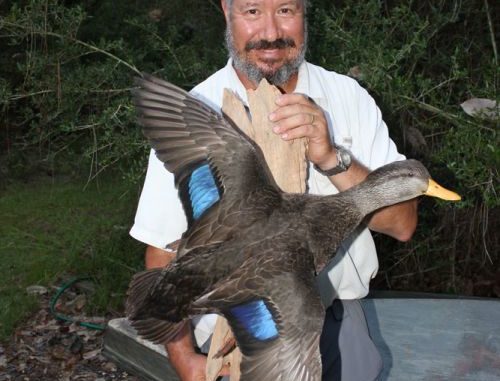
A true black duck — not what lots of area hunters call a mottled — is definitely a South Louisiana wallhanger. Learn how to tell the difference — and also tips that will help your taxidermist if you shoot a trophy this season.
Whatever the reason — from flooded corn fields up north, milder winters or any number of conspiracy theories floating around online — duck hunters in the Bayou State just haven’t seen masses of birds migrating to Louisiana’s dissolving wetlands compared to just a few generations ago.
But in South Louisiana, Mother Nature still sends an immense variety of birds — and every hunter hopes for an opportunity at one of those rarely seen exotic ducks.
Everyone has heard about “that guy” who shot a cinnamon teal, or has seen that aging goldeneye mount that was taken 30 years ago in a marsh that’s now underwater.
There’s little doubt, however, that if you are lucky enough to hit the exotic waterfowl lottery, the bird’s headed to your favorite taxidermist and is going on the wall.
But as rare as they might be, a lot of hunters would say a black duck just isn’t quite exotic enough — mainly because all duck hunters have killed one (or so they believe).
In classic Louisiana fashion, we’ve got a dozen different names for the same thing. Whether you learned to call it a black duck, a black mallard, a summer mallard, a mottled duck or a French duck, the reality is that hunters are probably talking about as many as three species that all appear very similar.
So it stands to reason that a Yankee bird that usually resides in New England and has half a dozen aliases often gets confused with its mottled Cajun cousin.
But, as Tony Cyprus Jr. can attest, a true, real-deal, olive-billed, red-legged black duck is absolutely a South Louisiana exotic — and it’s most certainly a wallhanger.
A true Big Branch black
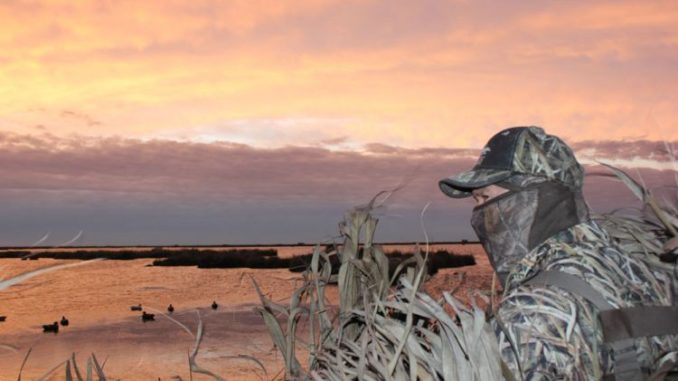
Nick Sicomo and Josh Gerard sat together in Cyprus’ Southfork flatboat dubbed “The Mothership,” begrudging the southerly flow producing less than ideal second-split hunting conditions.
“We ought to go solo this morning,” Cyprus said, looking for consensus as he killed the motor.
“Yeah, we should spread out,” Sicomo agreed. “They won’t be stacked up this morning.”
“Tony, you going to take the Honey Hole?” Gerard asked with hopeful inquisitiveness.
“No,” Sicomo quickly interrupted, “I am.”
Cyprus just laughed.
“Well, looks like it’s going to be Plan B for me,” he said.
The group paddled off into the morning darkness, each hunter taking a separate trenasse to gain access to the interior of the Big Branch Marsh National Wildlife Refuge.
The rest of the public-land army was in the lake, already scanning the marsh with their Q-beams. But these three diehards wanted to put some distance between them.
Hunting 500 to 600 yards apart, the trio traded pin drops of each other’s locations to ensure they wouldn’t be flaring each other’s working birds.
Naturally, Sicomo in the Honey Hole was getting plenty of action. He was getting good looks from greys, and he managed to bag a few for good measure.
Over at “Plan B,” Cyprus lit up when he saw the first four birds of the morning working in his direction. Two quickly peeled off, but the other pair made a beeline for his pond.
Tony took the first opportunity they gave him.
BAM!
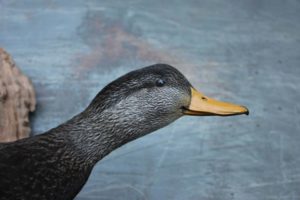
But when he finally got his pirogue to the bird, he immediately knew something was different: This duck wasn’t from Dixie.
After the hunt, Cyprus made it back to find Sicomo and Gerard waiting on him.
“No way this is what I think it is,” Cyprus said rhetorically, with the bird making a thud when he dropped it in Sicomo’s pirogue.
“Damn! It makes my greys look like pigeons,” Sicomo said. “What’s the story?”
Tony told how he though the flight of four was made up of huge mottleds coming in from the lake.
“Two landed in the bay in front of me, and the other two just kept coming in low, like missiles,” he said, his outstretched arms imitating cupping duck wings.
“Did you call? I only heard one shot from your direction,” Gerard said.
The hunter said he didn’t pick up a call.
“I was too weak in the knees to call, and they didn’t work my decoys, either,” Cyprus said. “They were coming down about 45 yards away, and I took the only shot I had.
“Hit him with one BB in the head.”
Gerard picked up the bird in disbelief.
“Man, it’s gotta weigh nearly 3 pounds,” he said. “I think you gotta black. I will kill you if you do anything other than get this bird mounted.”
Sicomo, a longtime hunter, added more certainty to the identification.
“It’s a black,” he said. “I saw one killed in the Chef Pass area. But that was more than 40 years ago.”
Now for the ol’ schoolers out there already muttering, “Yeah, yeah, it’s just another dark summer mallard,” world champion taxidermist Kevin Hynes actually mounted the bird — and left no room for doubt on the ID.
“It’s 100 percent real black duck,” Hynes said. “And I know my ducks. I’ve mounted several blacks over the years, and they’re usually taken by guys hunting east of Louisiana. I did one last year for a guy who had taken it on a guided hunt somewhere up the East Coast — Maryland, I think.
“But this is the first black I’ve ever done that was shot around here.”
Although there are plenty of look-a-likes and about twice as many nicknames for black ducks, Cyprus can tell you that the nom de plume “black duck” isn’t just another Louisiana handle for our local mottled.
Blacks are a legitimate out-of-town exotic, so if you’re on the hunt for that rarely bagged bird and carry a horseshoe in your shell bucket, pay close attention to that pair of late-season mottleds: You just might get a shot at a trophy black instead.
Old school style
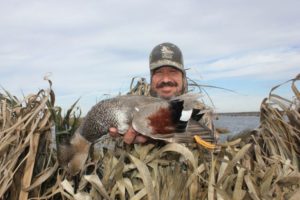
Mud boats just aren’t an option on Big Branch Marsh National Wildlife Refuge. But that’s of little concern to a seasoned old timer who regularly hunts the refuge with an original Ron Chapman pirogue.
“Mandevillian,” as Tony Cyprus Jr. goes by on the LouisianSportsman.com forum, regularly posts about his exploits in the marshes north of Lake Pontchartrain.
And Cyprus’ response to being asked to share some advice on those exploits was classic public land hunter.
“I ain’t giving you GPS coordinates to the Honey Hole” he said. “I can tell you how I hunt (ducks), but I’m not drawing you a map.”
But he said the key to his consistent public-land success is pretty straightforward.
“It really isn’t anything duck hunters haven’t already heard before,” Cyprus said. “Get away from the crowds and get hid.”
He works hard at doing both, and his most effective tool is that antique Chapman.
“I use my pirogue to get through shallow, shallow, shallow sections of broken marsh,” Cyprus explained. “This gives me access to the smaller pothole ponds.”
The hunter, along with his group of diehards, usually end up hunting about half a mile from a tree line that’s a natural ridge separating the marsh from high ground. It runs throughout Big Branch — from Slidell to Mandeville — parallel to Lake Pontchartrain.
This approach is definitely not for the lazy hunter.
“It can take some work to get back there,” Cyprus said.
Palmettos for pirogue camouflage
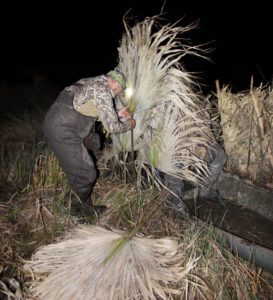
Given its proximity to the New Orleans and Baton Rouge metro areas, Big Branch gets plenty of attention from hunters, as well as ducks.
He also will be the first to tell you that if you’re not well hidden, the spot you end up hunting won’t matter much. Cyprus has a passion for creating unbelievable camo concealment, and the product he creates is something Delta Force would envy.
Most duck hunters have used palmettos to camouflage their blinds, but Cyprus has a go-to stash of giant palmetto fronds that he uses to completely encase his pirogue.
“I make like a palmetto teepee around my Chapman and get it tucked into the broken edges of the pond,” he explained. “I painstakingly make the tops of the fronds interlock to create a kind of goose pit blind in the marsh.
“It takes around 14 branches to cover both sides, and that fits fine in my ol’ Chapman.”
The palmettos also provide a secondary benefit: The palm stalks act like stakes to lock his pirogue in place.
“That lets me stay seated while I’m swinging around and when I’m shooting,” Cyprus said.
His two-pronged approach provides him with plenty of action to keep him returning to Big Branch.
“I’m a good ways off from the pressure around Lake Pontchartrain, and my blind has a really low profile that blends into the marsh so those inquiring eyes of greys won’t see anything out of the ordinary,” Cyprus said.
Know before you go
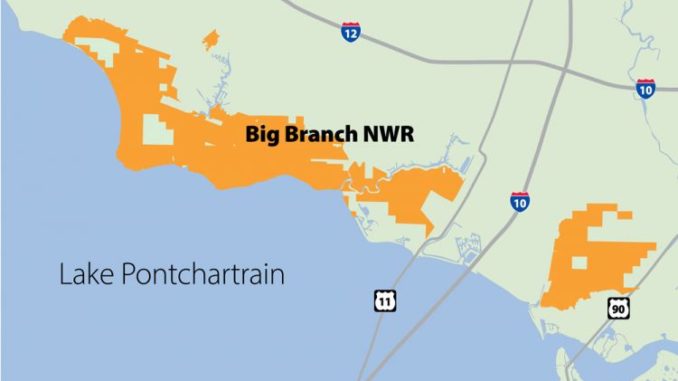 Anyone planning to hunt Big Branch Marsh National Wildlife Refuge should read the regulations before heading out, Tony Cyprus Jr. said.
Anyone planning to hunt Big Branch Marsh National Wildlife Refuge should read the regulations before heading out, Tony Cyprus Jr. said.
“The refuge has strict rules,” Cyprus explained. “You can’t be in there until 4 a.m.”
Hunting has to end by noon, and dekes and blinds have to be rounded up by 1 p.m.
And Big Branch is also closed on Mondays, Tuesdays and Fridays to give ducks a rest and, hopefully, get them to stick around a little longer.
Cyprus also cautioned against hunting without the refuge permit, as hunters are checked regularly — noting he’s a fan of the scrutiny.
“I like seeing the wardens out there,” he said. “It keeps the early birders from sneaking in too soon.”
ID’ing black ducks vs. mottled ducks
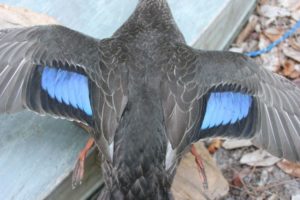
Any seasoned Louisiana duck hunter has been part of this conversation in the blind:
Shooter: “Bruh, this bird’s dark. You think its a black?”
Expert: “Let me see that bird. Annn, it’s gotta a little white on the bottom of the wing. I don’t think so.”
Shooter: “But it’s almost black, bruh — that little bit of white don’t matter.”
Expert: “A black’s gotta be black. That bird’s got brown feathers on it.”
Shooter (now convincing himself): “All ducks got brown feathers. This duck’s a black.”
Back at the camp he announces the now positive identification with, “I got a black mallard, y’all.”
And a legend is born.
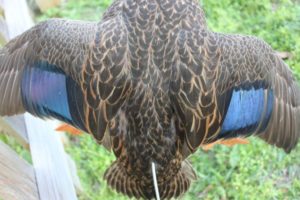
Given the name, hunters tend to assume the color of the bird is the best way to confirm its species; it’s obviously called a black duck for a reason, right?
But despite its name, hunters may not find the black feathers they are expecting to see. According to Paul Link, North American Waterfowl Management Plan Coordinator with the Louisiana Department of Wildlife & Fisheries, “There really aren’t many good/easy distinguishing features between them (black ducks) and mottled ducks.
“Mottled ducks typically have much more tan edging around their greater tertial coverts (shoulder feathers) than black ducks.”
When you have the benefit of side-by-side comparisons of known species, hunters can more easily see what Link is referring to.
The tan edging of the black’s feathers is more similar to a pinstripe when compared to a mottled’s tan edging, which is broader.
Therefore, the black duck’s dark appearance is not due to black feathers per se, but rather the reduction of the thickness of tan edging on the black’s body feathers.
“There are some more subtle differences in the throat, neck, and facial markings, but they are even less conspicuous,” Link said.
Where did you shoot it?
Another ID technique has nothing to do with the duck — where hunters take the bird is nearly as useful as the actual bird itself.
Link recalled, “I was quite surprised to learn at my first Mississippi Flyway Wingbee several years ago that the ‘expert’ wing checkers nearly always use the recovery location when a questionable wing comes across the table.”
It shouldn’t come as any surprise to local duck hunters that Louisiana is not a likely black duck recovery location.
In the 2014-15 season, 276 blacks were taken compared to nearly 29,000 mottleds. The percentage ratio held nearly the same for the 2015-16 season, when 154 blacks were taken compared to almost 14,000 mottleds.
And Link’s own experience aligns with those numbers as well. “I only hear from a couple people per year that kill black ducks here, and most are associated with mallards,” he said. “I’ve never heard of anyone killing a black duck flying with or paired with a mottled duck.”
In a state known for its hospitality, the black duck’s Cajun cousin doesn’t exactly fill that bill. That’s probably because mottleds don’t like to associate with any out-of-town ducks, regardless of similarities.
Link theorized that there might be a valid reason for the mottleds’ shyness.
“They are alone in the marsh without all the migrant ducks species. When the bluewings arrive in September, hunters fire up boats and ATVs and make a bunch of noise in a previously quiet marsh,” he said. “When most of the bluewings have passed on to Central and South America, the guns go quiet again.”
With this process repeating itself in big duck season, it’s of little wonder why local mottleds are decoy and call shy — they’re basically freaked out by all the tourists.
So on your next hunt, unless you find yourself on the East Coast, when you pick up that dark mottled duck give it a skeptical eye. Take a close look at the thickness of the tan edging on the bird’s body feathers.
And if it came in with a band of mottleds and stayed just outside the decoys … well you know the old saying: “Birds of a feather ….”
Editor’s note: Hynes can be reached at 985-863-0040, or through his website at taxidermybykevinhynes.com.